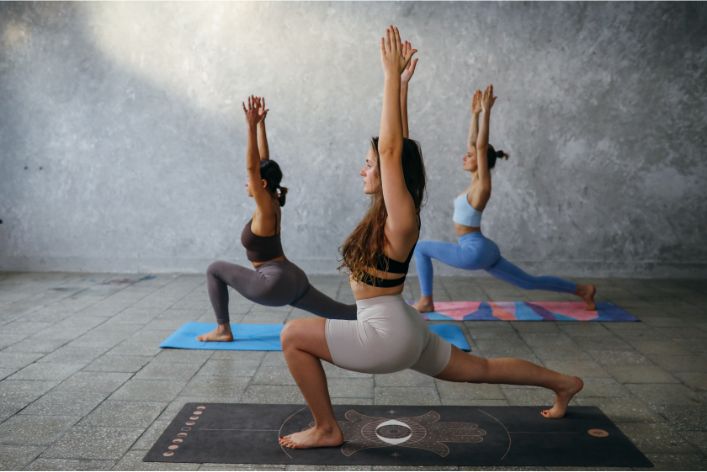Are you looking for a low-impact exercise that can improve your strength, flexibility, and mental well-being? Yoga and Pilates are two popular practices that can offer numerous benefits, but they are different in several ways.
Yoga is a centuries-old practice that originated in India and has evolved over time. It is characterized by a combination of physical postures, breathing exercises, and meditation techniques. Yoga offers physical benefits such as increased flexibility, strength, and balance, as well as mental benefits such as reduced stress and improved mood.

Pilates, on the other hand, is a relatively modern practice that was developed by Joseph Pilates in the early 20th century. It is a form of low-impact exercise that focuses on building core strength, improving posture and alignment, and developing a strong mind-body connection. Pilates can be adapted for different fitness levels and goals, making it a popular choice for people of all ages.
While both yoga and Pilates offer numerous benefits, they are different in several ways. Yoga tends to be more focused on spirituality and relaxation, while Pilates is more focused on physical conditioning and core strength. Additionally, the movements in yoga tend to be more static and held for longer periods of time, while Pilates movements are more dynamic and involve flowing sequences.
In this article, we will explore the similarities and differences between yoga and Pilates, the benefits of each practice, and provide guidance on how to choose between them based on individual goals and preferences. So whether you’re a seasoned yogi or a Pilates newbie, read on to discover which practice may be right for you.
Read: Why is Good Hygiene Essential for Health?
The History and Origins of Yoga and Pilates
Yoga and Pilates are two ancient practices that have been around for centuries. Yoga originated in India over 5,000 years ago and has evolved over time to include various styles such as Hatha, Vinyasa, and Ashtanga. It was developed as a spiritual and meditative practice that helped individuals achieve inner peace and balance.
Pilates, on the other hand, is a relatively modern practice that was developed by Joseph Pilates in the early 20th century. Originally known as “Contrology,” Pilates was created as a rehabilitation program for injured soldiers during World War I. It was designed to improve strength, flexibility, and overall physical health.
While both yoga and Pilates share some similarities in terms of physical movements and mind-body connection, they have different cultural and philosophical roots. Yoga is deeply rooted in Indian culture and philosophy, with an emphasis on the concept of dharma (duty or righteous action) and the belief in reincarnation. Yoga also incorporates the practice of meditation and mindfulness as a way to achieve inner peace and enlightenment.
In contrast, Pilates was developed in the Western world and is not associated with any particular religion or philosophy. It focuses more on physical conditioning and rehabilitation, with an emphasis on core strength, posture, and alignment. The principles of Pilates are based on six key concepts, including concentration, control, centering, precision, breath, and flow.
Despite their different cultural and philosophical roots, both yoga and Pilates offer numerous benefits for physical and mental well-being. They can be adapted for different fitness levels and goals, and both practices continue to evolve and grow in popularity today. Understanding the history and origins of these practices can help individuals gain a deeper appreciation for their unique benefits and differences.
Read: Can Mindfulness and Meditation Reduce Stress?
Yoga vs. Pilates: Similarities and Differences
Yoga and Pilates are both mind-body practices that offer numerous physical and mental benefits. While they share some similarities, they are also different in several ways.
Similarities between Yoga and Pilates:
- Both practices emphasize the mind-body connection and the importance of breathing.
- They can both help improve flexibility, balance, and posture.
- Both practices can help reduce stress and improve overall well-being.
Differences between Yoga and Pilates:
- Yoga tends to be more spiritual, while Pilates is more physical and exercise-oriented.
- Yoga focuses more on static postures that are held for longer periods of time, while Pilates involves dynamic movements.
- Yoga can be practiced in a variety of styles, such as Hatha, Vinyasa, and Ashtanga, while Pilates is typically practiced as a series of exercises.
Types of Yoga:
- Hatha Yoga: A slower-paced practice that focuses on basic postures and breathing exercises.
- Vinyasa Yoga: A more dynamic practice that involves flowing movements and breathing techniques.
- Ashtanga Yoga: A traditional practice that involves a specific sequence of postures and breath-synchronized movements.
Types of Pilates:
- Mat Pilates: A form of Pilates that is performed on a mat and focuses on building core strength and improving posture.
- Reformer Pilates: A more challenging form of Pilates that involves the use of a reformer machine to add resistance to movements.
- Clinical Pilates: A form of Pilates that is used as a rehabilitation tool to treat injuries and improve physical function.
Understanding the similarities and differences between yoga and Pilates, as well as the various styles and types within each practice, can help individuals choose the one that best fits their needs and goals. Whether you prefer the spiritual and meditative aspects of yoga or the physical conditioning and rehabilitation aspects of Pilates, both practices offer numerous benefits for physical and mental well-being.
Read: Why is Good Posture Crucial for Better Health?
Innovative Tech Solutions, Tailored for You
Our leading tech firm crafts custom software, web & mobile apps, designed with your unique needs in mind. Elevate your business with cutting-edge solutions no one else can offer.
Start NowBenefits of Yoga
Yoga is a practice that has been around for centuries and has numerous physical and mental benefits. It is a great low-impact exercise that can be adapted for individuals of all fitness levels and goals.

Physical Benefits of Yoga:
- Improved flexibility: Practicing yoga can help increase flexibility and range of motion in joints and muscles.
- Increased strength: Yoga postures require individuals to support their own body weight, which can help build strength.
- Better balance: Many yoga postures require balance, which can improve overall balance and stability.
Mental Benefits of Yoga:
- Reduced stress: Practicing yoga can help reduce stress and promote relaxation through breathing techniques and meditation.
- Improved mood: Yoga has been shown to improve mood and reduce symptoms of depression and anxiety.
- Better focus and concentration: Practicing yoga can improve focus and concentration, as well as cognitive function.
Adapting Yoga for Different Fitness Levels and Goals:
- Beginners: For beginners, it is important to start with basic yoga postures and gradually progress to more challenging ones.
- Individuals with injuries or limitations: Yoga can be adapted for individuals with injuries or limitations through the use of modifications or props.
- Advanced practitioners: Advanced practitioners can challenge themselves by practicing more challenging postures and sequences.
In conclusion, yoga offers numerous physical and mental benefits for individuals of all fitness levels and goals. From improved flexibility and strength to reduced stress and improved mood, yoga can help individuals achieve overall health and wellness. It is a practice that can be adapted for individuals with injuries or limitations, as well as advanced practitioners looking for a challenge. Incorporating yoga into a regular exercise routine can lead to improved physical and mental well-being.
Read: The Benefits of Yoga and How It Can Improve Your Health
Benefits of Pilates
Pilates is a low-impact exercise that focuses on building core strength, improving posture, and developing a strong mind-body connection. It offers numerous physical and mental benefits for individuals of all fitness levels and goals.

Physical Benefits of Pilates:
- Improved core strength: Pilates focuses on strengthening the deep abdominal muscles, which can improve overall core strength and stability.
- Better posture and alignment: Pilates can help improve posture and alignment, which can reduce pain and discomfort.
- Increased flexibility: Pilates movements can help increase flexibility and range of motion in joints and muscles.
Mental Benefits of Pilates:
- Improved concentration: Pilates movements require concentration and focus, which can improve cognitive function.
- Enhanced body awareness: Pilates can improve body awareness and help individuals better understand their body’s movements and alignment.
- Reduced stress: Pilates can help reduce stress and promote relaxation through breathing techniques and mindful movements.
Adapting Pilates for Different Fitness Levels and Goals:
- Beginners: Beginners should start with basic Pilates movements and gradually progress to more advanced movements.
- Individuals with injuries or limitations: Pilates can be adapted for individuals with injuries or limitations through the use of modifications or props.
- Advanced practitioners: Advanced practitioners can challenge themselves with more advanced movements and sequences.
In conclusion, Pilates is a practice that offers numerous physical and mental benefits. From improved core strength and posture to enhanced body awareness and reduced stress, Pilates can help individuals achieve overall health and well-being. It is a practice that can be adapted for individuals of all fitness levels and goals, making it a great choice for anyone looking to improve their physical and mental health. Incorporating Pilates into a regular exercise routine can lead to improved strength, flexibility, and overall well-being.
Which is right for you?
Choosing between yoga and Pilates can depend on individual goals, preferences, and physical conditions. Here are some factors to consider when deciding which practice is right for you:
Goals: If you’re looking to improve flexibility and reduce stress, yoga may be the better choice. If you’re looking to improve core strength and posture, Pilates may be the better choice.
Preferences: Do you prefer a spiritual and meditative practice or a physical conditioning and rehabilitation practice? Consider which practice aligns better with your personal preferences.
Physical Condition: Consider any injuries or physical limitations you may have. Yoga may be more accommodating for individuals with joint issues, while Pilates may be better for individuals with back pain or posture issues.
When selecting a class or instructor, consider these factors:
Teaching Style: Each instructor has their own teaching style. Some may be more focused on relaxation and meditation, while others may be more focused on physical conditioning.
Experience: Look for an instructor with experience teaching the specific type of yoga or Pilates you’re interested in.
Certifications: Look for an instructor with proper certifications from accredited organizations.
Getting started with either practice can be easy. Here are some tips:
Attend a beginner’s class: Most studios offer beginner’s classes that can help you get started and learn the basics.
Start slowly: Don’t try to do too much too soon. Start with basic movements and gradually progress to more advanced ones.
Listen to your body: If something doesn’t feel right, don’t do it. It’s important to listen to your body and not push yourself too hard.
In conclusion, choosing between yoga and Pilates can depend on individual goals, preferences, and physical conditions. When selecting a class or instructor, consider teaching style, experience, and certifications. Getting started with either practice can be easy by attending a beginner’s class, starting slowly, and listening to your body. With consistent practice, both yoga and Pilates can help individuals achieve improved physical and mental health.
Conclusion
We have explored the similarities and differences between yoga and Pilates, their history and origins, and the physical and mental benefits of each practice.
Both yoga and Pilates offer numerous benefits for physical and mental well-being, including improved flexibility, strength, posture, and reduced stress. They can be adapted for individuals of all fitness levels and goals.
While yoga tends to be more focused on spirituality and relaxation, Pilates is more focused on physical conditioning and core strength. However, both practices can be adapted to suit individual needs and goals.
We encourage readers to try both practices and see which one works best for them. It is important to remember that both yoga and Pilates require consistency and commitment to achieve their benefits. With regular practice and guidance from a qualified instructor, individuals can achieve improved physical and mental well-being through these practices.
Before You Go…
Hey, thank you for reading this blog to the end. I hope it was helpful. Let me tell you a little bit about Nicholas Idoko Technologies. We help businesses and companies build an online presence by developing web, mobile, desktop, and blockchain applications.
We also help aspiring software developers and programmers learn the skills they need to have a successful career. Take your first step to become a programming boss by joining our Learn To Code academy today!
Be sure to contact us if you need more information or have any questions! We are readily available.










